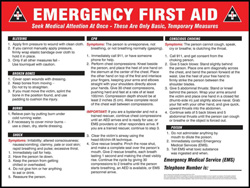| The Home page of ILPI's Safety Data Sheet (SDS) Resource, the leader in SDS information since 1995! | |
| The history and philosophy behind this resource. | |
| A curated collection of books and reference materials concerning Safety Data Sheets and closely related topics. | |
| Paste your plain text SDS into the SDS-Demystifier, and it will be converted into a hypertext-enriched document with links to detailed explanations of each key term. | |
| An extensive list of frequently asked questions about Safety Data Sheets including regulations, content, compliance, and more. | |
| A humorous take on Safety Data Sheet jargon. Fill in the blanks on our entry form to generate a personalized Unsafety Data Sheet to share with your coworkers. | |
| Since 1995, we've maintained this massive curated list of the best places to find Safety Data Sheets on the Internet. | |
| You are here! Way more than a glossary, this hypertext-enhanced resource covers hundreds of SDS-related terms and expert knowledge. Each entry includes both the SDS relevance and links to additional authoritative resources. | |
| Archived results of Safety Data Sheet related polls taken by some of our millions of site visitors | |
| The OSHA regulations behind SDS regulations, including the inspection guidelines and over 400 official interpretations letters under the Hazard Communication Standard | |
| Commercial suppliers of SDS authoring and management software as well as cloud compliance services. | |
| Commercial companies that will create SDS's for your specific needs as well as SDS translation companies. |

Safety signs, banners, and scoreboards? Get yours at Safety Emporium!
Definition
Paresthesias are skin sensations, such as burning, numbness, itching, hyperesthesia (increased sensitivity) or tingling, with no apparent physical cause (idiopathic). The most common locations of paresthesias are the hands, arms, legs and feet, although paresthesias can occur anywhere on the body.
Additional Info

We have all kinds of first aid signs, posters and labels at Safety Emporium.
There are many possible causes of paresthesia - too many to list here. Some examples include:
- Physical nerve damage.
- Inadequate blood supply to the affected region.
- Pressure on the spinal nerves (e.g. herniated disk, tumors).
- Carpal tunnel syndrome or other repetitive stress injuries.
- Various long-term medical conditions (e.g. diabetes, underactive thyroid, migraine headaches, multiple sclerosis).
- Transient ischemic attack (temporary and focal loss of cerebral function, "ministrokes").
- Stroke ("brain attack").
- Certain medications.
- Toxic action on nerves, such as that from lead, mercury or arsenic. See also poison and neurotoxin.
A common cause of unexplained skin irritation is getting chemicals on yourself without realizing it. For example, if a small amount of a substance was spilled and not cleaned up, someone might later rest their arm or hands on the spill area and be exposed without realizing it. In addition, those who are sensitized (allergic) or have chemical hypersensitivity can exhibit symptoms even on exposure to trace amounts of certain subtances.
If you notice any of the symptoms of paresthesia or have other unexplained medical issues, you should see your doctor for a physical examination and possible treatment.
Books Available
NOTE: We may collect a share of sales or other compensation from the links in the following list:
- Paresthesia: A Revised and Updated Study Revised, Updated Edition", Hardcover, 102 pages, 2015. Estimated price $58.29. Info and/or order .
- "The Official Patient's Sourcebook on Paresthesia: A Revised and Updated Directory for the Internet Age", Paperback, 120 pages, 2002. Estimated price $28.95. Info and/or order .
- "Pick Your Poison: How Our Mad Dash to Chemical Utopia is Making Lab Rats of Us All", Hardcover, 256 pages, 2011. Estimated price $19.24. Info and/or order ILPI recommended.

Encourage safety on the job with electronic safety scoreboards from Safety Emporium.
SDS Relevance
Paresthesias can appear on a Safety Data Sheet as a symptom of exposure to a number of toxic substances such as lead, mercury or arsenic, neurotoxicants, or skin irritants. These effects may or may not be reversible. Consult Section 11 (toxicological information) of the SDS for symptoms of exposure. Appropriate personal protective equipment (PPE) such as gloves, aprons, goggles, dust masks etc. may be recommended in Section 8 (exposure controls/personal protection) of the SDS. Follow good chemical hygiene and clean up all spills promptly and completely.
Further Reading
- Numbness and tingling at NIH/NLM's MedLine Plus Medical Encyclopedia.
- The NIH's National Institute of Neurological Disorders and Stroke's Paresthesia Information Page.
- What Is Paresthesia? at Healthline.
- Paresthesias: A Practical Diagnostic Approach from Fam Pract. 1997,56 (9), pp 2253-2260.
- Causes of Tingling and Numbness (Paresthesia) at HealthHype.com.
- What is the best diagnostic approach to paresthesias of the hand? from Fam Pract. 2002,51(12), pp 1076-1078.
- Numbness (paresthesia and neuropathy) at the Autoimmunity Research Foundation.
See also: Irritant, sensitizer, urticaria.